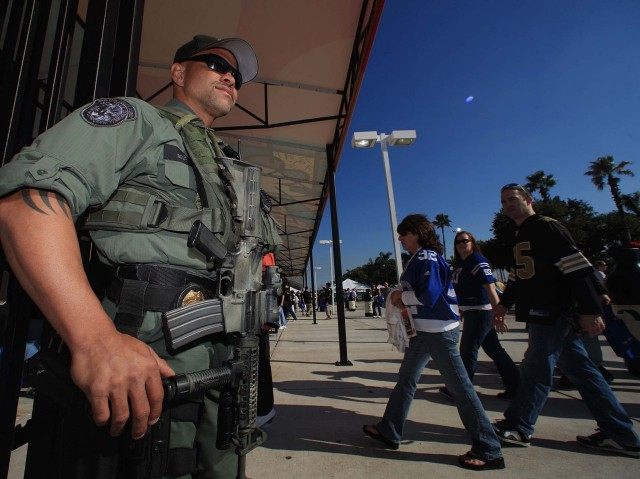The security pros protecting the Super Bowl have an increasingly tough job

Minneapolis MN Jan 2018 On Feb. 4, nearly 67,000 people will fill Minneapolis’ U.S. Bank Stadium for Super Bowl LII. As many as a million people will be in the city for related events and festivities.
Almost everyone will be focusing on the New England Patriots and the Philadelphia Eagles — almost everyone except police and first responders (and not because the hometown cops are sore about the Vikings). Instead, for local, state and federal law enforcement, and for the hundreds of private security officers backing them up, the focus will be keeping people safe.
Threats to the big game are embedded in our cultural consciousness, from the sniper in “Two-Minute Warning,” to the plastique-and-flechette-laden blimp in “Black Sunday,” to a nuclear bomb in “The Sum of All Fears.” But the past three years have confirmed that it’s not just Hollywood fiction: Large-scale events in the real world are enticing targets.
Since 2015, the Stade de France, Manchester Arena and the Las Vegas Village venue have been attacked by terrorists and murderers because they promised victims and attention — and potentially because they were seen, accurately or not, as soft targets. For Minneapolis, as for New York City when it hosted Super Bowl XLVIII during the first month of my second term as the city’s police commissioner, the goal is to ensure that the game, the stadium and all the associated sites and events are anything but unprotected.
The NYPD started planning almost as soon as the National Football League awarded the Super Bowl to New Jersey and New York in 2010; I’m confident it’s been no different in Minneapolis. In New York City, fans were protected by our patrol cops, as well as cops from the NYPD’s Emergency Services Unit, our mounted and canine divisions, our aviation and harbor police and more than a dozen other units. Thousands of cops on 12-hour shifts covered events in all five boroughs, particularly around Madison Square Garden in Manhattan, Barclays Center in Brooklyn, and 13 blocks of Broadway in Times Square that the NFL transformed into “Super Bowl Boulevard.”
We deployed technology, too, including license-plate readers, tools for screening people and vehicles, radiation detectors and hundreds of temporary surveillance cameras to supplement the thousands of extant public and private cameras.
Without revealing specific methods and tactics, I can say that Minneapolis Police Chief Medaria Arradondo and the men and women of his department will almost certainly be using all the same tools. In particular, they will be monitoring crowds, looking for unusual behavior or items. As it was at MetLife Stadium in 2014, attendees at U.S. Bank Stadium in 2018 will have to dress warmly, and that will make screening that much more complicated. Since public safety is a shared responsibility, attendees can help significantly by knowing the rules for what they can and cannot bring beforehand.
Some of those rules have changed, because today law enforcement faces threats that we didn’t in 2014. Over the past four years, terrorists have weaponized drones. Lone-wolf attacks and vehicle-ramming attacks have spiked, and cyberattacks have become more sophisticated and more prevalent. The NFL and its capable security chief, former Washington, D.C., Police Chief Cathy Lanier, have done a great deal to address these new challenges. They have, for example, worked to ensure that venues adopt stadium-security best practices, certified under the federal Department of Homeland Security SAFETY Act.
This kind of collaboration is tremendously important. In 2014, the NYPD worked closely with officials from the FBI and DHS, as well as the New York State Police, New Jersey State Police, Amtrak Police, and many, many other municipal, local, state, federal and private agencies. In 2018, there will be just as many agencies working together in Minneapolis as there were in the Meadowlands. Because of this, coordinating assignments — and, if necessary, emergency response — will require good communications and pre-existing relationships.
Additionally, regional cellphone providers and the provider at U.S. Bank Stadium will need to augment coverage for crowds and first responders, and be prepared to distribute alerts and emergency messages.
If the first responders have taken a page from the athletes on the gridiron, they’ll have trained like they play. On game day, they’ll leave it all on the field. They won’t get a trophy and a huge ring — I’m from Boston; that ring will probably end up on Tom Brady’s finger — but they’ll have done everything they can to ensure that everyone has a great time and goes home safe. That’s a job worthy of champions.




